
views
Toning Exercises
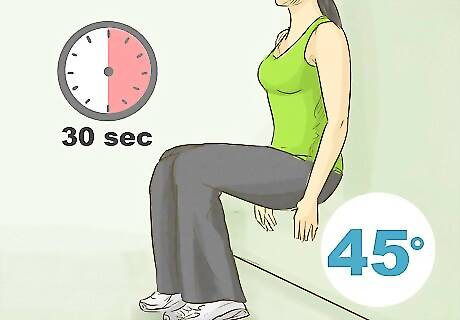
Practice wall squats. A wall squat is an isometric exercise that will help give your thighs a leaner appearance. To do a wall squat, place your back against a flat wall and bend your knees to a 45-degree angle. Hold this position for 30 seconds, then stand up and rest. Do four sets of 10 reps. You can also try some squat variations like reverse lunges, goblet squats, step-ups, barbell hip thrusts, and barbell squats.
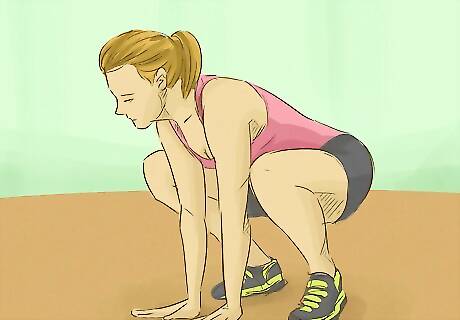
Do around-the-room froggies. This exercise is a bit of cardio coupled with toning. The combination of strengthening and cardio will help you burn major calories while targeting your inner thigh muscles. Stand with your feet wide and your knees and toes pointed outward. In this position, your hand should be reaching down to the floor (picture a sitting frog!). Squat down as low as you can, but keep your chest up and make sure your knees are aligned over your toes. Jump up in the air and rotate your body a quarter turn while bringing your feet together. While you jump, swing your arms over your head to help propel your body. Land in a squat (the squat should be as deep as possible). And jump up again until you complete a full rotation (four jumps will constitute a full rotation). Repeat as many times as possible for 1 minute. Then, repeat while rotating in the opposite direction.
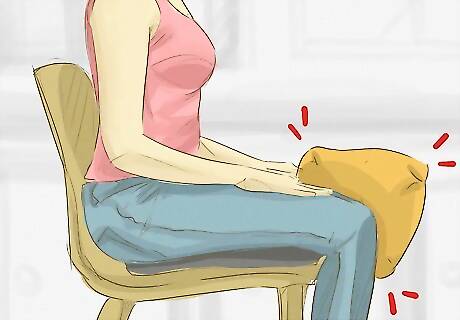
Attempt the seated pillow squeeze. This exercise can be done in your kitchen with no specific workout equipment; instead, it only requires a kitchen chair and a pillow from your living room couch. Sit on a sturdy chair (one that does not have wheels), and rest your feet flat on the floor with your knees bent at a right (90-degree) angle. Place the pillow between your knees and thighs. Exhale as you squeeze the pillow between your thighs. You should imagine it as if you are attempting to squeeze the stuffing out of the pillow. Hold this squeeze for 1 minute, and breathe normally while doing this.
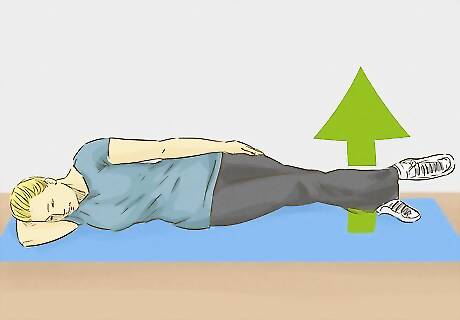
Try side lying hip adduction. This exercise targets your adductors, the muscle group that runs along the inside of your legs. Doing this move will help increase muscle tone and will assist in burning off the layer of fat on your inner thighs when combined with regular cardio exercise. Lie down flat on your side. Your legs should be straight out with one foot stacked on top of the other. You can bend your bottom arm and place in under your head for support, while you rest your other arm at your side, letting your hand fall on your upper hip. Your hips and shoulders should be perpendicular to the floor and your head should be aligned straight with your spine. Support your spine by tensing your abdominal muscles and bring your lower leg forward. It should lie in front of your upper leg. At this point, both legs should still be straight, but the foot of the upper leg should be brought down to the floor so that both feet are resting on the floor. Raise your lower leg off the floor. Breathe out and gently lift your lower leg so that it rises above the foot of the upper leg. Raise your legs until your hips begin to tilt or until you feel tension in your lower back or oblique muscles. Inhale and return your leg to the floor in a controlled manner. Gradually roll over so that you are resting on your other side. Repeat the exercise, stretching your other leg, to finish one set. Repeat this lift 10 times; do this for three sets on each side, alternating sides.
Weight Loss Exercises
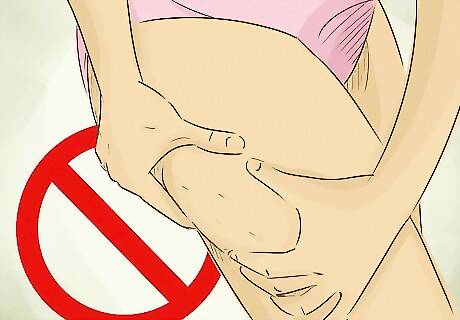
Don’t attempt to “spot reduce.” It is not possible to lose fat specifically in your inner thigh region. To lose this fat, you will need to reduce your overall body fat. It is essential to be realistic in what you can expect from your weight loss. There is no specific exercise that will target just the fat in your thighs.
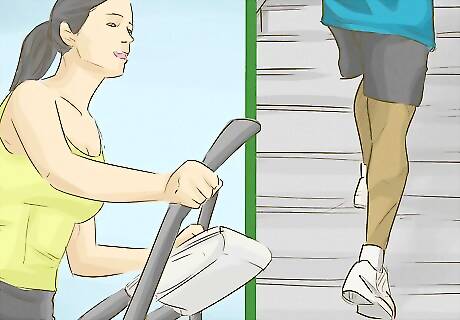
Increase your cardio workouts. Cardiovascular exercise is a great way to burn fat. In order to lose overall body fat (and thereby also lose fat in your inner thigh region), you should increase the amount of time that you do cardiovascular exercising or increase the days that you do cardiovascular exercise. Cardio workouts are particularly well-suited to assist with the appearance of your thighs because most cardio exercises work the lower body, which can tone and shape your thighs as you lose weight For popular cardio exercises to try, look to elliptical training, running, stair climbing, jumping rope, and brisk walking. Exercise at least a half hour a day 5 days a week in order to increase your fat burning. Always consult with your physician before beginning a workout routine to make sure that you are healthy enough for moderate to intense exercise.
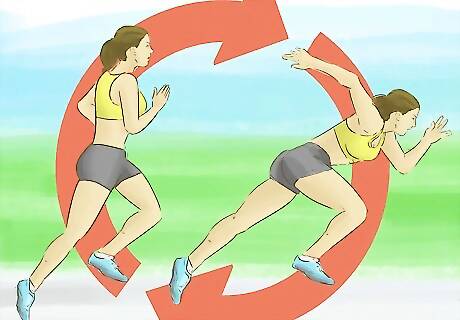
Try interval training. Interval training involves alternating intense bursts of vigorous activities with periods of lighter activity. For example, you can alternate between walking and jogging (five minutes each, repeated for a total of 30 – 60 minutes), or you can alternate between jogging and running. Doing interval workouts will burn more calories, and thereby will burn more fat. Aim for 30 minutes or more of interval training four to five times each week.
Eating to Lose Weight
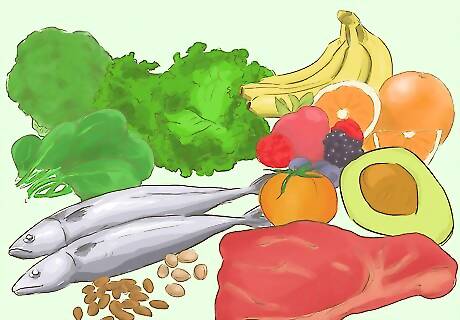
Eat a clean diet. In order to lose weight, you should get most of your calories from low-calorie and nutrient-dense food sources. Make sure to include foods such as high-quality proteins (including lean meats and nuts), fruits, vegetables, and complex carbohydrates (including whole wheat breads, legumes, and brown rice). Avoid heavily processed foods whenever possible. These include some foods that are frozen (including frozen pizza) and pre-made meals (including microwavable meals). These foods have been processed to compensate for the nutrition lost during the process it took to preserve the food. Choose fresh foods as often as possible.
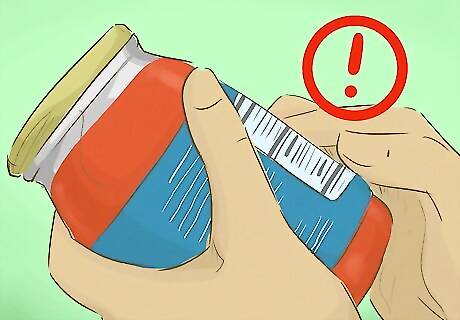
Limit your intake of saturated fats. Saturated fats are less beneficial to your body than unsaturated fats and are usually found in animal sources, like dairy and meat, as well as hydrogenated oils. Many of our favorite desserts are filled with saturated fats, so make sure you limit your intake of sweets. Palm and coconut oils contain the highest amount of saturated fat, but butter and rendered animal fats like lard and shortening contain a considerable amount of saturated fat as well. Fish oil, for all its healthy omega-3 fatty acids, also contains a high percentage of saturated fat, so it is important to read the nutrition labels on the foods you purchase and limit your portion sizes when eating foods that are high in saturated fats. It is important to note that you should limit, not exclude, saturated fats from your diet. The occasional saturated fat is fine, especially if it offers other health benefits, such as fish or nuts.

Skip the red meat and go for lean protein. Simply put, lean protein sources have less saturated fat and fewer calories. Replace beef and pork with chicken and turkey. Fish is also lower in fat than most red meat and has additional health benefits. When possible, you should opt for fresh fish over sardines, tuna, or other fish packed in oil. Legumes like lentils, chickpeas, and pinto beans also pack a considerably high amount of low-fat protein. These foods will help you to feel full and will provide you with the necessary nutrition so that you aren’t deprived of essential nutrients as you eat a low fat diet in order to lose weight.
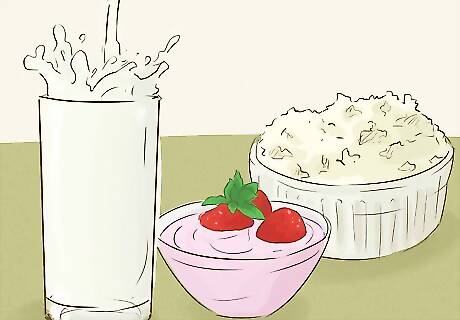
Eat plenty of low-fat dairy. Calcium helps regulate the way that fat cells store and break down fat, while low-fat dairy (such as milk and yogurt) can help promote weight loss. Particularly for women, who are especially prone to osteoporosis, it is crucial to include a sufficient amount of low-fat dairy in your diet. Choose low-fat dairy instead of whole or no-fat dairy. Think two-percent or one-percent milk instead of whole milk or fat-free milk. Low-fat dairy options are often better that non-fat dairy, which are usually packed full of sugars. Include more milk, yogurt, and cottage cheese in your diet. These dairy sources are lower in fat than most hard cheeses, creams, and butters. Anyone over the age of nine years should consume approximately 3 cups of dairy per day. Children aged two to three years should consume approximately 2 cups of dairy each day, while children ages four to eight years old should consume about 2.5 cups of dairy each day.
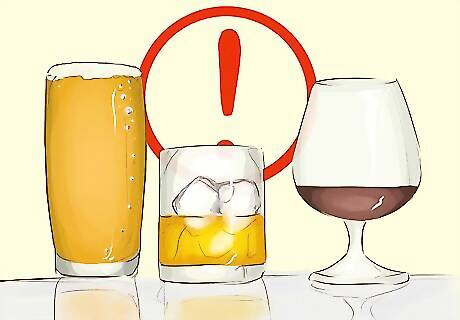
Limit your alcohol intake. Alcohol is a source of empty calories that you will want to cut out of your diet as much as possible in order to lose weight. Your body reduces its fat-burning by nearly 75% after just one and a half drinks in order to rid itself of the by-products of alcohol (acetaldehyde and acetate). Thus, the fat and carbs that you eat have a greater chance of being stored as fat. Even moderate consumption of alcohol can increase the amount of calories you consume, can decrease your motivation for exercising, and can negatively impact your sleep. If you do choose to drink, drink in moderation. This means one or fewer drinks daily for women and two or fewer drinks daily for men. (One drink is equivalent to 12-oz of beer, 5-oz of wine, or 1.5-oz of liquor).

Avoid diet-busters. While there is some room for forgiveness in your diet, there are certain foods and drinks that are more likely to throw your diet off altogether. These should be avoided as much as possible. Take foods with empty calories and no nutritional benefit out of your diet. Drinks like soda and foods like frozen French fries and sweet breakfast cereals should be avoided.
Loving Your Body

Be realistic. Realize that you are probably your own worst critic, and you notice your inner thigh fat more than anyone else does. Ask yourself: do my thighs need as much work as I think they do, or am I seeing more inner thigh fat than really exists? Evaluate if you are being overly critical of your body. You may want to ask a trusted family member or close friend for an honest evaluation of your inner thigh fat. This person can help you identify if this is an area that may need some slimming and toning, or if you are being overly critical of your own body. For a true medical evaluation of the state of your body, visit your doctor. They can provide accurate information about areas in which you collect fat and can help you calculate your Body Mass Index (BMI) and understand exactly what it means.
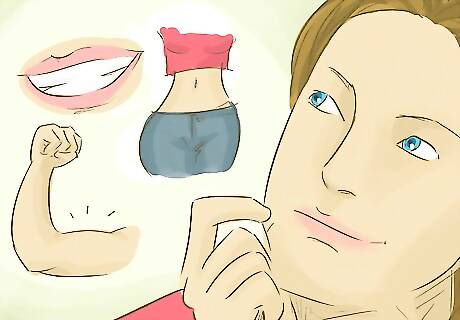
Look for the positives. While your thighs may have more fat than you would like, there are other parts of your body that should be a source of pride. Do not spend all your time focusing on your “problem areas.” Instead, make sure you spend some time recognizing the features of your body that make you feel beautiful and accentuate these areas when possible. Name three parts of your body that are attractive and make you feel good. You might have strong arms, a flat belly, straight teeth, or bright green eyes. Whatever part of your body you like the most, make sure you highlight this feature.
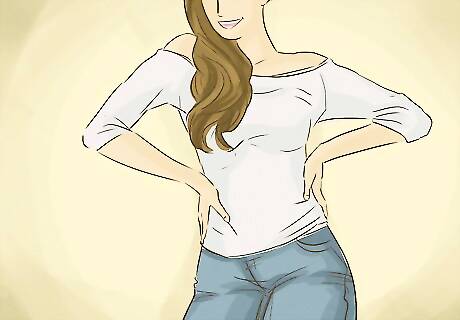
Appreciate your body. Your body is an amazing machine that carries you through your daily life. It may help you to pay greater attention to what your body can do on a daily basis. Remember that your body is an instrument, not just an ornament. Appreciate that your strong thighs allow you to lift up your child or grandchild, walk up a flight of stairs, and play hopscotch in your driveway.



















Comments
0 comment